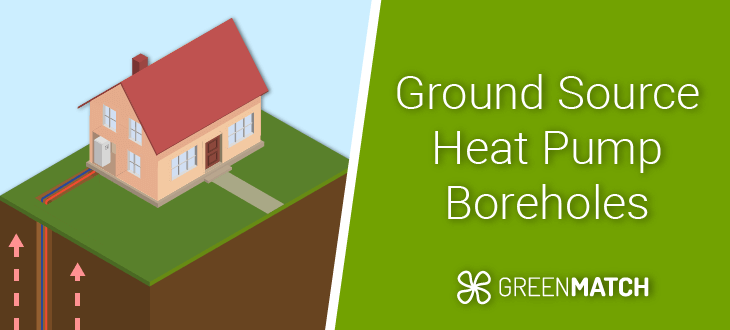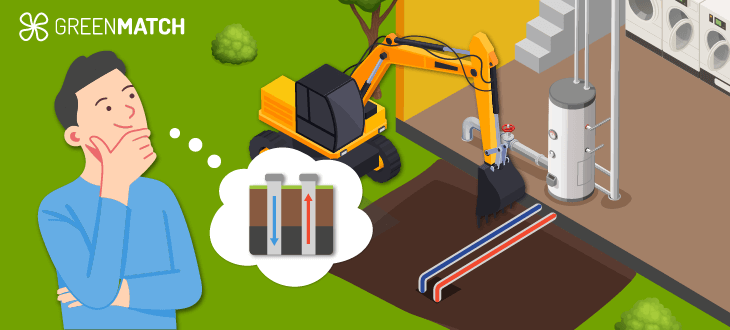Answer these simple questions and we will find you the BEST prices
Which type of solar quotes do you need?
It only takes 30 seconds
100% free with no obligation

Get up to 4 quotes by filling in only 1 quick form

Install a heat pump for less with the BUS grant

We’ve helped over 500,000 homeowners reduce their carbon footprint
- GreenMatch
- Ground Source Heat Pumps
- Ground Source Heat Pump Borehole
Ground Source Heat Pump Borehole


- Ground source heat pump boreholes are dug deep into the ground to extract the thermal energy from underground rocks to provide your home with heating, cooling and hot water.
- 1-3 ground source heat pump boreholes typically range from £10,500 - £37,000, including additional groundwork costs.
- Borehole depths typically range from 50m to 200m with diameters typically ranging from 110 to 150mm.
For most UK homes, a ground source heat pump typically requires 1-3 boreholes. They are buried deep into the ground, typically between 50 - 200 metres. Boreholes help save outdoor space and let more homes enjoy the benefits of geothermal heating.
In the article, we'll cover everything you need to know about boreholes, like the process of creating them, how much they cost, and the most important considerations for anyone who'd like to install a vertical ground source heat pump for their home.
We can also guarantee you a good deal on new ground source heat pump installation through our exclusive quotes service. It's simple: fill in our 30-second form, then we'll connect you with up to 4 of the best heat pump installers in your area. You can then compare their quotes and choose the one you'd like to work with.
Our process saves you hours of time spent researching installers by yourself. You can rest assured that all of the installers in our network have been vetted by us. You're also under no obligation to accept any of the quotes you receive.
To get your free, tailored installer quotes, click the button below.
- Quotes from local engineers
- Payment by finance available
- Save £7,500 with BUS grant
It only takes 30 seconds



- What is a ground source heat pump borehole?
- Ground source heat pump borehole cost
- Process of making a borehole for ground source heat pumps
- Ground source heat pump borehole depth
- What to consider before installing a borehole?
- Is a ground source heat pump with a borehole the right fit for my home?
- Frequently asked question
What is a ground source heat pump borehole?
Ground source heat pump boreholes are vertical ground arrays designed to extract heat energy from the rock formations beneath the Earth's surface. This rock provides a renewable source of thermal energy for ground source heat pumps.
Typically, each borehole requires a 150mm width of garden space. Borehole depths typically range from 50m to 200m. This means that if you have any space restrictions outside, drilling a borehole for your ground source heat pump installation may be the right choice, as most of the space it takes up will be below the ground.
While a more affordable alternative may be a horizontal ground loop, where shallow trenches are dug horizontally, these require considerably more space outside your property. For those with little outdoor space, vertical ground loops offer a practical, space-saving solution.
They can also provide more efficient levels of heating throughout the year since temperatures deep in the ground are more consistent.
There are two primary types of boreholes applied to either closed-loop and open-loop ground source heat pumps. Boreholes for closed-loop ground source heat pumps are the most common between the two. The ground loop is placed in the drilled well that is dug deep from 50m to 150m in the ground.
The heat pump then circulates a heat transfer fluid through the U-pipe. This low-temperature fluid absorbs the Earth's thermal energy and transports it to the heat pump. Once the fluid releases its energy to the heat pump, it returns to the borehole, and so the cycle continues.
Ground source heat pump borehole cost
Ground source heat pump borehole costs will typically range from £10,500 - £37,000. This depends on the size of your home, which helps decide how many boreholes you need.
Total costs might range from £36,000 - £64,500, considering the heat pump unit itself, and the additional installation jobs such as laying pipes and groundworks.
| Installation element | Estimated cost |
|---|---|
| Ground source heat pump | £11,500 - £27,000 |
| Groundworks (including 1-3 boreholes) | £10,500 - £37,000 |
| Piping | £2,000 - £4,000 |
As a general rule, you will need 1 borehole for every 6kW. A larger system, such as a 16kW unit requiring 2-3 boreholes, may result in total costs ranging from £50,500 to £64,500.
| Ground source heat pump size | Number of boreholes required | Installation costs (borehole, piping, groundwork costs) | Estimated total costs |
|---|---|---|---|
| 8kW | 1-2 | £16,000 - £27,000 | £36,000 - £47,000 |
| 12kW | 2 | £16,000 - £27,000 | £40,000 - £51,000 |
| 16kW | 2-3 | £23,000 - £37,000 | £50,500 - £64,500 |
The complexity of the installation can also greatly impact the total cost. Various factors influence the cost of drilling boreholes, including site conditions, construction methods, and underground environment.
Do bear in mind that ground source heat pump costs do vary when it comes to installation. The company you choose to work with can have a considerable bearing on the cost. This is why we always recommend that you compare multiple quotes before choosing an installer.
To help with this, use GreenMatch's free, no-obligation quotes service. Rather than spend hours researching the best installers in your area, our service can make this much easier for you. Simply fill in our form, then you'll receive up to 4 exclusive quotes from the top-rated installers in your area.
Get started today by clicking the link below.
- Quotes from local engineers
- Payment by finance available
- Save £7,500 with BUS grant
It only takes 30 seconds



Process of making a borehole for ground source heat pumps
During the making of a borehole, a specialised drilling rig penetrates the Earth, reaching up to 200m. A U-shaped straight pipe is then inserted into the borehole during installation, connecting to the ground source heat pump through a trench.
The space surrounding the U-pipe within the borehole is backfilled with thermal grout, ensuring efficient thermal conductivity from the Earth to the borehole pipe.
1. Drilling:
In closed-loop boreholes, a drilling rig digs to depths of up to 200m, with borehole diameters typically ranging from 110 to 150mm. The specific machine used and the borehole pipe diameter, usually between 32 to 40mm, influence the overall dimensions of the borehole.
2. Preparation:
Once the specialised drilling rig has delved deep into the ground, a metal casing is inserted into the borehole to the required depths. This helps prevent the sides from collapsing during the rest of the installation process.
3. Piping:
A U-shaped straight pipe is inserted into the borehole, and connected through a trench to the ground source heat pump.
A smaller tremie pipe, approximately 25 to 40mm in diameter, is fixed around the U-pipe within the borehole. This space is then filled with thermal grout, which allows for the absorption of thermal energy from the ground to the circulating heat transfer fluid within the borehole.
4. Finishing touches:
After the boreholes are created, the pipes are attached to the geothermal loops, and laid underground to a concealed manifold chamber, where the borehole pipes meet. This is where energy transfer to the heat exchanger or heat pump takes place.
To ensure the integrity of the system, a drilling contractor will conduct a pressure test. They will then issue you a certificate before leaving the site.
Ground source heat pump borehole depth
Typically, each borehole requires 150mm width of garden space. Borehole depths typically range from 50m to 200m.
For borehole depths below 110m, a 32mm diameter loop is required. For borehole depths above 100m, a 40mm diameter is required.
For borehole depths of 100-120m, a 32-40 diameter loop is required. If you're installing multiple boreholes, then they should be placed at least 5m apart from each other.
It typically takes a weeks work to install 3 boreholes, assuming there aren't any complications or disruptions to the installation.
What to consider before installing a borehole?
Given the extent of the work required for vertical ground source heat pump installation, there are some important pre-installation considerations to decide upon. Take a look at some of these below.
Drilling site preparation
- Before installing ground source heat pump boreholes, it's important to remember that the process inevitably brings some disruption to the area.
- Therefore, you should be prepared for potential deconstruction work required to grant access to the drill rig and anticipate subsequent building work to restore the site.
Ground conditions assessment
- Conducting a geological survey is important to understanding the ground conditions, and heat transfer characteristics, or revealing potential mines, sewage pipes, or gas pipelines.
Spacing between boreholes
- For projects involving multiple boreholes, maintaining a distance of 5 to 6m between boreholes prevents interference and allows the ground to recover its heat.
Sizing and efficiency considerations
- Borehole performance relies on factors such as geological conditions, thermal conductivity, heating distribution system efficiency, and building heat demand.
- Careful sizing and efficiency assessment are important in determining the required borehole depth. For example, a medium-sized home that requires a borehole of 100m borehole, can expect 4kW of extractable heat to meet their heating demands.
Is a ground source heat pump with a borehole the right fit for my home?

Ground source heat pump boreholes are most commonly applied to commercial sites, or residential sites like new build apartments or social housing.
In cases where multiple properties share a single ground loop, the borehole depths or quantities are typically streamlined compared to individual system installations. Otherwise, they are especially suited to compact sites with little available horizontal space.
If you're still unsure whether a new ground source heat pump is right for your home, then it's best to consult a professional installer who can assess your home's suitability and advise you as to the advantages and disadvantages of a ground source heat pump.
To be connected to up to 4 professional installers from within our UK-wide network, then complete our short form today - it only takes 30-seconds!
With multiple installers to choose from, you're best placed to find a good deal. You'll also save yourself hours of helpless online research. All of the installers in our network have been thoroughly vetted and we will only connect you to the best installers within your area.
It's free, fast, and you're under no obligation to accept any of the quotes you receive. Click the button below to get started.
- Quotes from local engineers
- Payment by finance available
- Save £7,500 with BUS grant
It only takes 30 seconds



Frequently asked question
Boreholes for ground source heat pumps typically range from 50 – 200 metres deep, depending on the size of the system and your heating needs.
The cost of drilling 1-3 boreholes in the UK typically range from £10,500 – £37,000, including additional groundwork costs.
Depending on the size of the heat pump and your heating needs, you will likely require between 1-3 boreholes, each between 50 – 200 metres deep.

Ciaran is a content writer at GreenMatch. Whether writing about sustainable aviation fuel or heat pumps, Ciaran has passion for informing readers about pivotal technologies that are reshaping our world.
We strive to connect our customers with the right product and supplier. Would you like to be part of GreenMatch?

- Ground Source Heat Pump Borehole
- What is a ground source heat pump borehole?
- Ground source heat pump borehole cost
- Process of making a borehole for ground source heat pumps
- Ground source heat pump borehole depth
- What to consider before installing a borehole?
- Is a ground source heat pump with a borehole the right fit for my home?
- Frequently asked question
- Quotes from local engineers
- Payment by finance available
- Save £7,500 with BUS grant
It only takes 30 seconds



Stay up to date with energy saving tips and grant alerts
Receive offers, marketing and promotions via email from Leads.io about GreenMatch and our brands/partners to help you save.
Thank you for subscribing to our newsletter!
Your email has been successfully added to our list. We look forward to sharing our latest updates with you soon!



